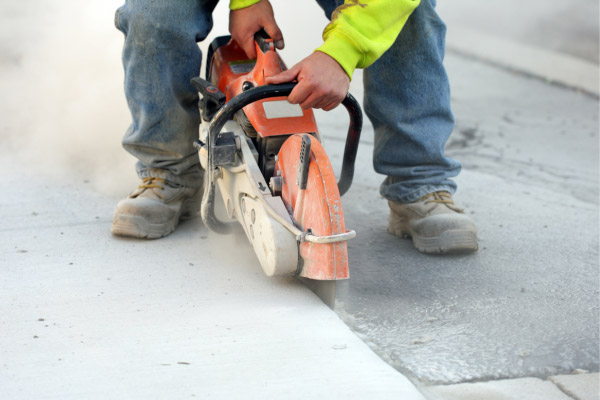Concrete is one of the hardest substances to cut. Cutting it precisely, and safely, requires the right equipment, tools, and skill. If you’re new to cutting concrete, we’ve put together this list of best practices to show you how to do it safely and accurately.
- Safety first
Before you begin cutting concrete, make sure the following safety measures are in place:
- Remove or cover any obstacles nearby, such as furniture, vehicles, etc.
- If you’re cutting indoors, fasten plastic over doorways to contain dust and debris.
- Turn off and cover vents to the mechanical system to avoid spreading dust.
- If you’re working outdoors, prune bushes or trees to keep the area clear.
- Wear the correct personal protective equipment (PPE), including:
- Heavy, long-sleeved shirt, pants, and steel-toed boots
- Strong gloves
- Face shield
- Hearing protection
- Dust mask or respirator (where workers are exposed to silica dust, you must follow all OSHA safety precautions, including providing and wearing respirators with the proper APF factor)
- Knee pads/shin protectors
- Use GFCI-protected extension cords and outlets.
- Choose the correct tool
There are several tools that can be used to cut concrete, from a chisel to walk-behind circular saws. Knowing which one to use for your project is key. The right tool allows you to safely make the cut(s) you need in an efficient manner. Here are some of the tools you can use to cut concrete and the projects they are best for:
- Hammer and chisel – Perfect for small jobs, like breaking concrete bricks or pavers, when a clean break is not required.
- Circular saw – Their compact size makes them perfect for cutting concrete blocks, pavers, and walls.
- Angle grinder – While not the normal intended use for this tool, an angle grinder can be used to make cuts in concrete pavers, cement board, blocks, and walls when necessary.
- Cut-off saw – A handheld saw used for cutting concrete, stone, and asphalt.
- Air concrete saw – An air-powered handheld saw that is used for cutting through concrete, reinforced concrete, asphalt, and masonry.
- Street saw – Available in walk-behind and handheld models, these saws work best for street repairs, utility work, and curb cutting.
- Air walk-behind saw – These are pneumatic-powered and provide good handling for cutting concrete, brick, and stone.
- Wheel trencher – They are best used on large projects, like cutting streets, highways, or large areas of concrete pavement.
To protect workers from dust during cutting, it’s best to use a wet saw or one with a vacuum attachment.
- Measure the cut
The next step is to measure and mark the cut you need to make. Use bright chalk or crayon to delineate the line for each cut. Crayon is best when using a wet saw, as chalk will wash off.
- Prepare to cut
While the saw is off, set the cut depth to the length of the teeth on the saw blade (you may have to make multiple passes to make a deep cut). Put on all required PPE and make sure no one is in the path of the cut. If using a dry saw, wet the slab before cutting to reduce dust.
- Make the cut
Connect a vacuum or hose to the saw as required. Turn the saw on, let the blade make the cut, and guide the saw along the marking. For deeper cuts, use step cutting. Make a series of shallow cuts over the same line, going slightly deeper each time.
FAQs about concrete cutting
Can you cut concrete with a circular saw?Yes, with the proper PPE, blades, and the proper suction or water to prevent dust flying into the air, you can cut concrete with a circular saw. See the practices above for PPE and blade requirements.
How do you cut concrete flush with the wall?There are two options for saws that can cut close to a wall: a toe kick saw or an undercut saw. The toe kick saw has a blade attached to a regular saw but with a lengthy joint. The joint allows it to access tight spaces and make cuts. Undercut saws are another option. The blade on these saws is mounted perpendicular to the body of the saw.
How do you cut concrete with an angle grinder?Cutting concrete with an angle grinder is similar to using a circular saw (see practices above). Circular saws tend to cut faster and create straighter lines, but an angle grinder can be used if needed. Be sure to use a diamond blade to ensure a clean cut.
How do you cut concrete smoothly?Making a smooth cut depends on a couple of factors:
- Use the correct blade and make sure it’s sharp – When dry concrete cutting, use diamond saw blades with serrated edges, and when wet cutting, use diamond saw blades with smooth edges.
- Cut at the right time – The best time to cut concrete for a smooth finish is when it is dry but not completely set (around 12 hours after it is poured in cool weather conditions, and in hotter conditions, around 4 hours after).


